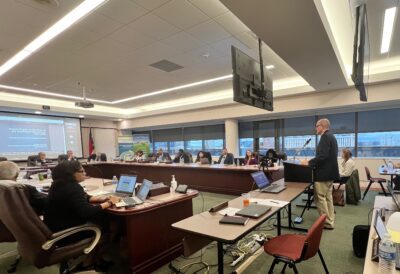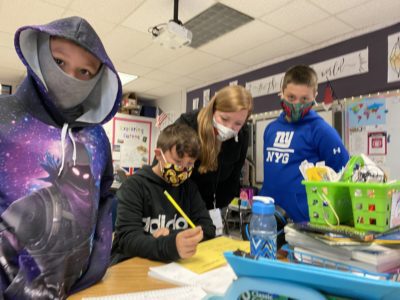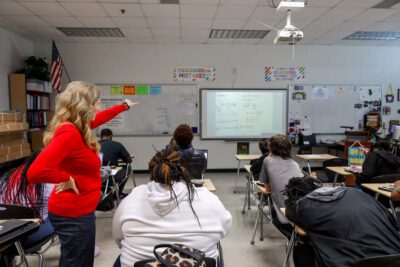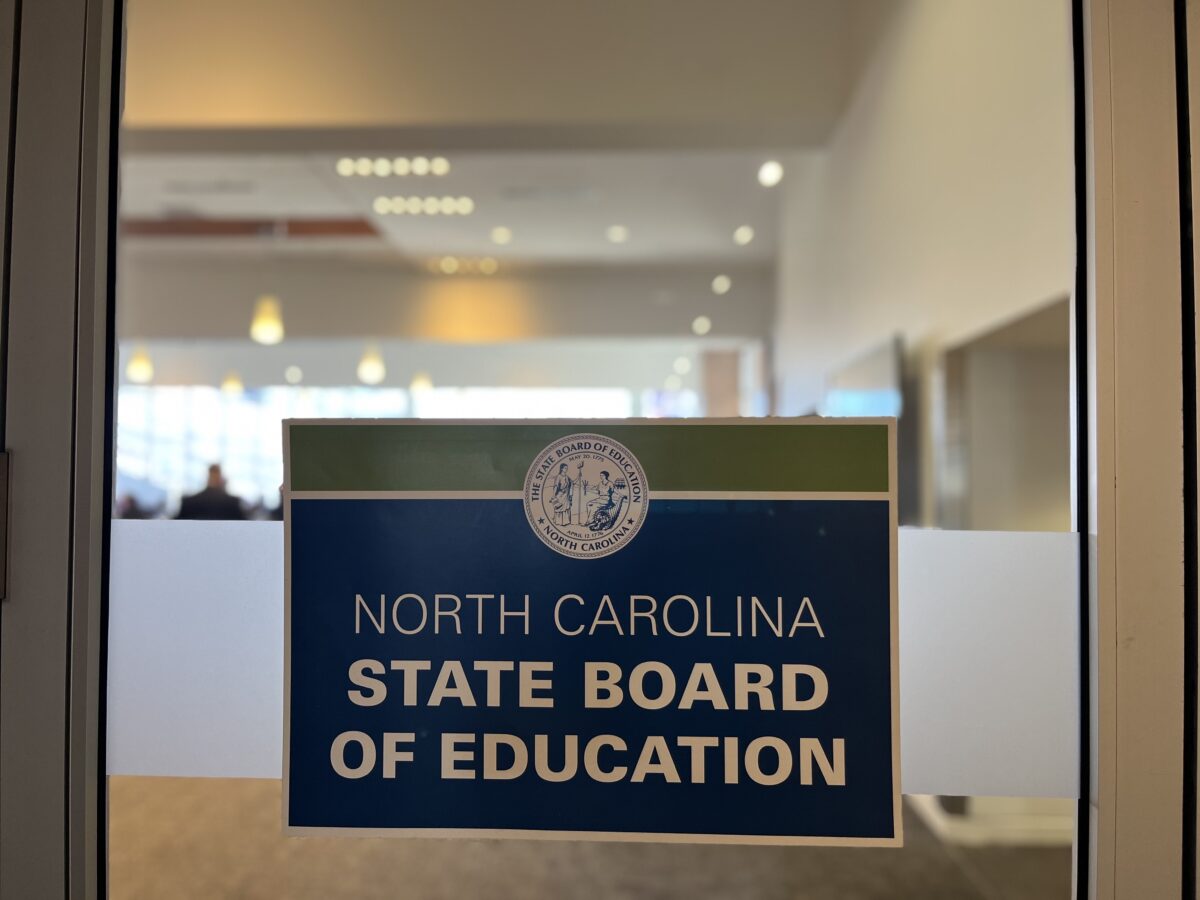

Share this story
- A new report shows that 11.5% of North Carolina teachers left their role last school year. Read more about teacher turnover, vacancies, and efforts to support teachers in North Carolina.
- The attrition rate for beginning teachers was higher than the overall rate, at roughly 15%. Beginning teachers are defined as teachers in their first three years on the job.
|
|
Teacher turnover, also known as attrition, in North Carolina increased during the 2022-23 school year, according to new data from the Department of Public Instruction (DPI).
The data, which is part of DPI’s annual state of the teaching profession report, shows that 11.5% of teachers left their role last school year. That’s compared to 7.8% of teachers who left teaching the year before.
Dr. Tom Tomberlin, senior director of DPI’s Office of Education Preparation and Teacher Licensure, told the State Board of Education on Wednesday that it’s important to contextualize the higher turnover rate.
North Carolina has consistently been able to hire enough teachers to replace the ones who left, he said, and has maintained an attrition rate below the national average. Tomberlin also pointed out that turnover increased at higher rates in other North Carolina state agencies.
“When we saw this, we started thinking about, ‘Well, how do we understand this? Is this the darkening of the skies and the thunderclaps? Or can we think about this in context?'” Tomberlin said. “You can see historically, we have replaced more than 100% of those teachers that left in the prior year… If the trends were reversed, this would be a serious, serious issue.”
Take a look at the teacher attrition and vacancy data below. Note that the number of vacant teacher positions also rose and is now at 6.4%. The vacancy count includes classrooms that have a teacher, but not one who is fully licensed.


The attrition rate for beginning teachers was higher than the overall rate, at roughly 15%. Beginning teachers are defined as teachers in their first three years on the job.
A few Board members said the state should increase starting pay for beginning teachers and support for college students pursuing teaching degrees. The 2023 state budget did give larger raises to beginning teachers, increasing base pay from $37,000 to $41,000 over the biennium.
“These trends highlight the importance of providing enhanced support for early-career educators, including those who enter the profession through the residency license pipeline,” said State Superintendent Catherine Truitt. “With nearly half of new teachers coming to us through alternative teacher preparation programs, we need to take a close look at how to better differentiate supports for those educators.”
You can view DPI’s full presentation on teacher attrition here, and the full report to the General Assembly here.
You can also look at DPI’s data dashboard, which includes attrition data from every district between March 2022 and March 2023, as well as 2020-21 and 2021-22. The dashboard includes data on teacher resignations, moving between districts, and retirements.
The first tab in the dashboard includes district, regional, and statewide data on attrition, mobility, and recoupment. Note the drop-down menu for a year, region, LEA, and low-performing.
The second tab includes district and statewide data on teacher vacancies, including the first 40 days, day 40, by subject, grade level, and other hard-to-staff variables, like Exceptional Children.
The third tab includes the reasons for teacher attrition. The fourth tab is teacher attrition by years of experience. The fifth tab is EVAAS index scores by attrition and years of experience.
Read on for more information on turnover, vacancies, and what the state is doing to build a stronger teacher pipeline. For more context about teacher attrition data, check out this EdNC article.
More on attrition data
Attrition is defined by DPI in the report as “a reduction in the number of employees that occurs when employees leave an employing unit.” It is measured on the state level and district level.
As noted above, the turnover rate last school year was 11.5%, or 10,373 teachers.
Teachers self-report multiple reasons for resigning. Nearly half of the teachers counted in the state attrition rate cited what the state considers a “personal reason” to leave, according to the report. The most common personal reason given was a career change, which 17.2% of teachers reported. The next most common reason given was retirement with full benefits, at 13%.
Some districts and regions are impacted more by attrition than others.
The Sandhills region, for example, had the highest regional attrition rate, at 12.6%. That region includes Cumberland, Hoke, Montgomery, Moore, Richmond, Robeson, Sampson, Scotland, Columbus, and Bladen counties.
The districts with the highest and lowest attrition rates are Halifax County Schools and Yancey County Schools, at 18.3% and 4.2%, respectively.
Among beginning teachers, turnover was highest for teachers with less than one year of experience, at 26.5%. The rate was also high for teachers with more than 35 years of experience, at 25.6%.
In his presentation to the state Board, Tomberlin said Board policy regarding beginning teachers is mostly likely to have the largest impact. Veteran teachers, he said, are likely to remain or leave based largely on financial reasoning.
Concerning beginning teachers, Tomberlin cited the need for policies like mentor support and manageable workloads.
He also said the pipeline to acquiring a permanent residency teaching license is “leaky.” Of the 2,547 teachers issued a permit to teach in the 2018-19 school year, approximately 55% converted to a residency license by 2020-21.
“This data suggests not all teachers in their first three years of the profession are receiving the benefit of beginning teacher support programs,” Tomberlin said. “Our beginning teachers need targeted support, including evidenced-based professional development, individualized coaching, and meaningful opportunities to engage with their most effective colleagues.”
Vacancy data
There were 90,638 teachers employed in North Carolina public schools between March 2022 and March 2023.
State law defines vacancies as teaching positions in a district that are not filled by someone with a qualifying educator license. Those licenses include a continuing professional license (CPL), initial professional license (IPL), residency license (RL), or a limited license.
Under that definition, retired teachers, interim teachers, long-term substitutes, and teachers with an emergency or provisional license or a permit to teach do not count as being in a permanent placement.
During the 2022-2023 academic year, there were 6,150 statewide instructional vacancies on the first day of school, up 610 positions from the previous year.
On the 40th day of school, there were 6,006 vacancies — an increase of about 915 positions from the previous year.
“In many cases, the positions reported as vacant on the first instructional day were different from those reported as vacancies on the 40th instructional day,” the report says. “This suggests that teacher vacancy is a continual issue that LEAs must contend with throughout the school year.”
Tomberlin told the Board the increase in vacancies over the last two years results from school districts working to accurately report under the new definition of what a vacancy is.
Under the old vacancy model, he estimated the 6.4% vacancy rate for 2022-23 would be 3.7% or lower.
“It’s important to note that a vacancy does not equal a classroom with no teacher,” Tomberlin said. “More than half of these positions are filled by fully licensed educators who, based on the legislative definition, we must count as a vacancy. Because of the change in statute to define vacancies, directly comparing vacancy rates to prior years is no longer valid.”
The majority of vacancies are concentrated in elementary school core areas, with 1,387 open positions. In North Carolina, there are more elementary schools than middle and high schools.
Openings for STEM subjects and Exceptional Children (EC) were also high. There were approximately 937 vacancies for middle and high school math and science teachers last school year, according to the report, and 1,203 vacancies for EC teachers.
The state’s vacancy rate ranged from 31.3% in Vance County Schools, to 0% in Tyrrell, Graham, Alleghany, and Mitchell County Schools.
Mobility, recoupment, and replenishment
Another way that teacher attrition is measured in the report is through mobility.
Mobility is when an educator who is employed in one district in March of one school year is employed in a different district the following March. Teachers who move between schools in the same district are not included in the count.
Teachers who move districts are considered a loss for the district they left, but not a loss for the state.
From March 2022 to March 2023, the state mobility rate was just over 5%.
The district with the highest mobility rate was Weldon City Schools, at 17.4%. Eight of the district’s 46 teachers left for another district during the 2022-23 school year. Graham County Schools had the lowest mobility rate, with none of their 90 teachers changing districts last school year.
Some districts make up for teacher losses by capitalizing on mobility. The rate at which districts can attract transferring teachers to their district is called the “recoupment rate.”
Greater rates of recoupment mean that a district will need to hire fewer new, less experienced teachers to replace teachers they lost in the prior school year, the report says.
Tyrrell County Schools had the highest recoupment rate at nearly 64%, replacing seven of their 11 departed teachers with teachers from other districts.
Another important factor in considering school turnover data is the state’s replenishment rate.
While turnover increased in North Carolina last school year, the state is still hiring more teachers than were lost.
According to the report, 11,023 educators were hired in September 2023 after 10,373 teachers left during the previous school year. The replenishment rate – based on the number of new hires – has averaged 122.8% over the past six school years, Tomberlin said.
“It’s encouraging to see that so many people are interested in and excited about working in North Carolina public schools,” he said. “Year after year, school and district leaders do an excellent job of recruiting teachers to make sure all student needs are met.”
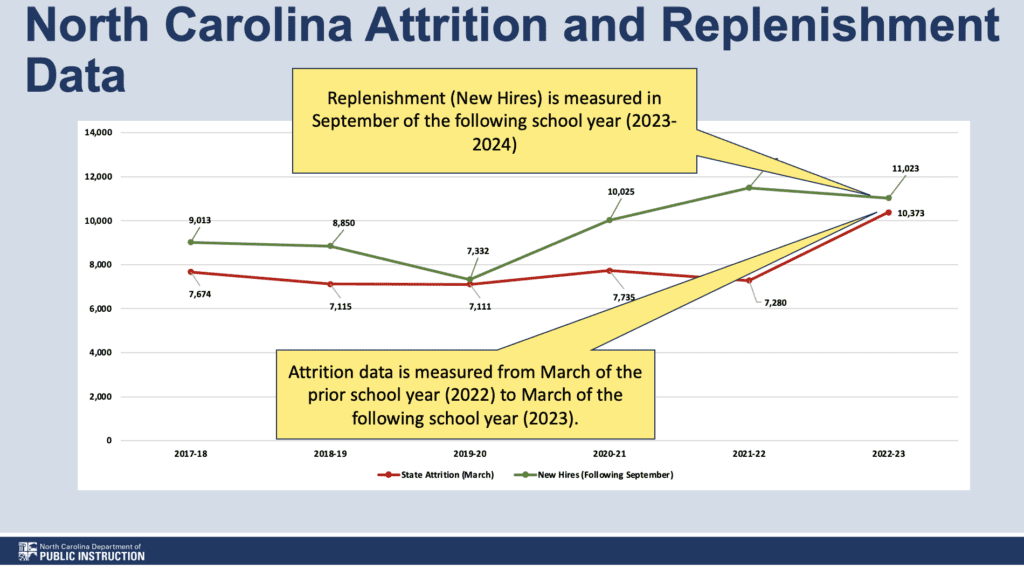

State and district supports for teachers
Different factors can impact the turnover rate of educators at all experience levels.
During his presentation, Tomberlin cited the need for more mentor support, manageable workloads, and guidance for beginning teachers.
On Thursday, the Board also heard a presentation on regional partnership approaches to teacher recruitment and retention in the southeast. Here is a quick look at some of those strategies:
- What Works! is a southeast regional partnership between the DPI Southeast Regional Support Team and the UNCW Watson College of Education. It was started in March 2022 to increase collaboration and the exchange of information, brainstorm potential challenges, and scale actionable ideas. In spring 2023, What Works! southeast regional superintendents formed a task force to further analyze regional attrition data.
- The UNCW Watson College of Education’s Professional Development System (PDS) School-University Partnership, which was created in 1993 to provide classroom learning opportunities for future teachers. PDS includes a network of more than 2,000 teachers and spans 11 school districts, a university laboratory school, and two public charter schools in Southeastern North Carolina.
- PDS’ New Teacher Support Program, which currently supports 81 beginning teachers in two districts, and has supported nearly 300 teachers over five years. PDS also created 2024 Beginning Teacher Learning Labs, which will focus on planning, instruction, and assessment. The learning labs include 25 teachers across six districts.
During his presentation, Tomberlin also said the state must better support new teachers entering classrooms under alternative licensure routes. The number of those teachers has increased by 23.3% since the 2017-18 school year and now makes up 44% of all new educators in the state.
Truitt said the Pathways to Excellence plan to overhaul licensure and teacher pay in North Carolina could help with teacher turnover.
Last March, the State Board of Education voted to ask lawmakers for authorization to run a six-year pilot of the plan. Lawmakers did not discuss the pilot during last year’s legislative long session.
Pathways would increase beginning teacher support, Truitt said, while also shifting how teachers are paid. People entering the workforce today do not want to wait 30 years to realize the economic and retirement benefits of working as a teacher, she said.
“I will continue to recommend that the state consider redesigning its teacher licensure and compensation system so that beginning teacher support is embedded earlier and systematically throughout a teacher’s career,” Truitt said.
There are several other initiatives in North Carolina meant to support teachers.
Project EPIC: Exceptional Educators who are Proficient, Inclusive, and Culturally Competent is a new program to help recruit teachers, facilitated by North Carolina Agricultural and Technical State University and funded by a $1.1 million grant from the U.S Department of Education’s Office of Special Education.
Project EPIC focuses on recruiting and preparing students from underrepresented groups, including multilingual individuals and those with disabilities, who are interested in pursuing a four-year undergraduate degree in elementary education and obtaining a special education teaching license.
Project EPIC co-founder Dr. Gerrelyn Patterson, who is chair of N.C. A&T’s Department of Educator Preparation, said the project can “redefine the process of preparing aspiring special education teachers.”
“Through rigorous preparation, supplemental professional development, and sustained hands-on experiences at Aggie Academy and local schools, students in the program will not only earn their degree in elementary education but will also obtain a special education teaching license, equipping them with the knowledge and skills needed to enhance outcomes for students with disabilities,” Patterson said.




The North Carolina New Teacher Support Program (NTSP) is a statewide initiative of the University of North Carolina General Administration. The program, which partners with 10 public universities, focuses on personalized professional development, feedback, resources, and confidence-boosting among new teachers.
Since the program was founded in 2014, the program has supported 9,300 teachers. The NTSP’s goal is to combat attrition and vacancy rates through their coaching so that there are more effective teachers. NTSP analysis shows that the probability of a school retaining a teacher was nearly three percentage points higher when they participated in the program.
Of the administrators NTSP surveyed, 96% said that the program improved teacher confidence and quality.
“Teacher vacancy and attrition rates are concerning in NC, and some schools/districts are more susceptible to these challenges than others, e.g. districts with higher populations of non-white students,” a NTSP one-pager says. “Targeted recruitment efforts and new pathways are helping but must be paired with a focus on retention and improved instructional quality.”
And on Thursday, the North Carolina Teaching Fellows Commission announced a record 462 award recipients for the 2024-25 academic year. That number is the highest since the program’s return in 2017.
The Teaching Fellows program is a merit-based forgivable loan program that provides tuition assistance up to $10,000 per year for qualified students committed to teaching elementary education, special education, science, technology, engineering, or math in a North Carolina public school.
“We are excited about the tremendous growth and interest in the Teaching Fellows program, which has expanded to include educator preparation programs at Appalachian State University and East Carolina University, and now also serves future teachers in elementary education fields,” said Dr. Bennett Jones, director of the North Carolina Teaching Fellows Program. “We are grateful for the support of lawmakers and education policy leaders as we continue to recruit, train, prepare and place high-quality teachers across the state.”
This story was produced with support from the Education Writers Association Reporting Fellowship program.







